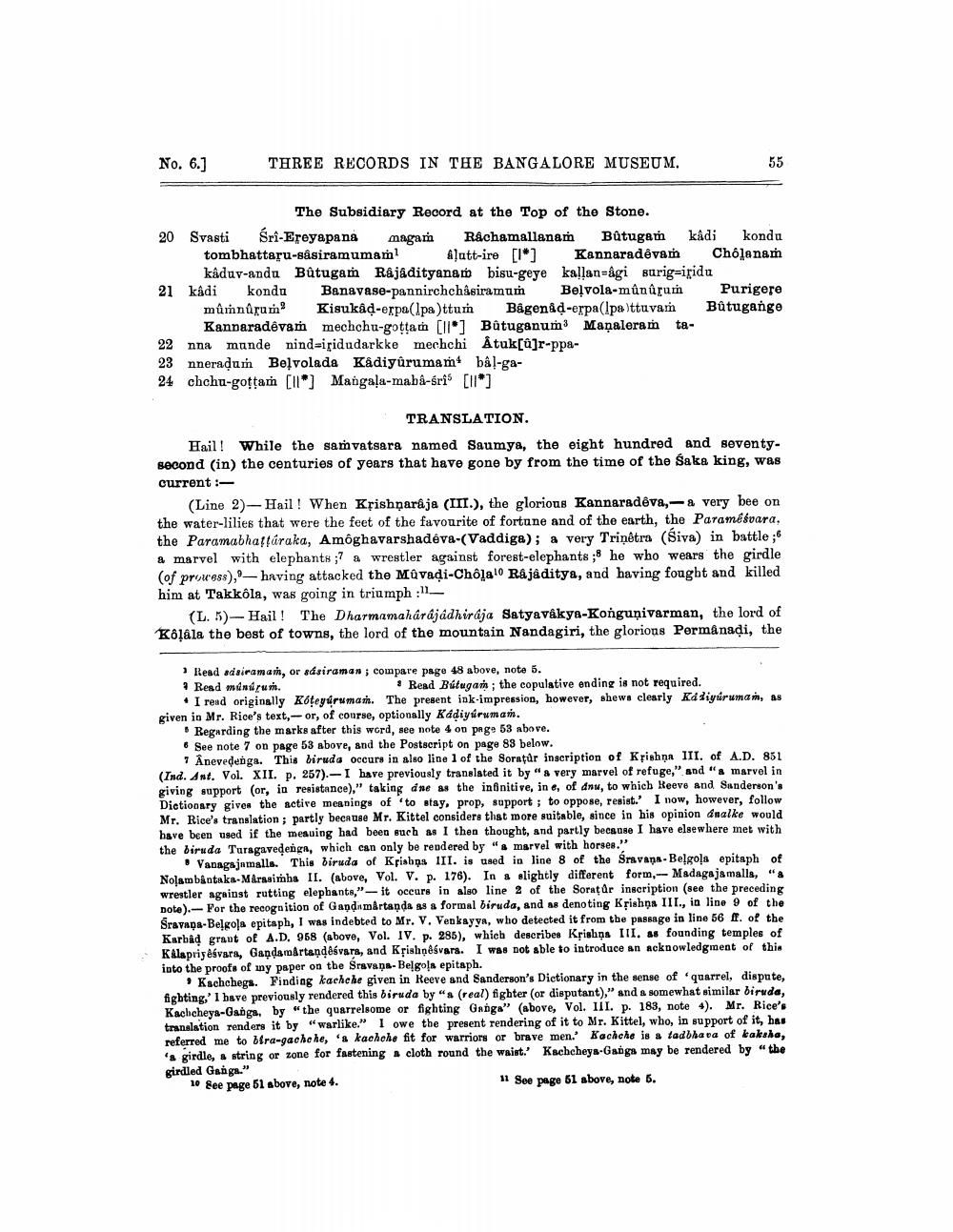________________
No. 6.]
20 Svasti
THREE RECORDS IN THE BANGALORE MUSEUM.
The Subsidiary Record at the Top of the Stone.
Śrî-Ereyapana magam Rachamallanam Bûtugam kâdi kondu tombhattaru-sâsiramumam1 Alatt-ire [*] Kannaradevam Chôlanam kâduv-andu Bâtugam Râjâdityanam bisu-geye kallan-âgi surig=igidu kondu Banavase-pannirchchâsiramum Belvola-mûnûrum Purigere mûmnûrum2 Kisukâḍ-expa(pa)ttum Bâgenaḍ-erpa (lpattuvam Bûtugange Kannaradevam mechchu-goṭṭam [*] Bûtuganum Manaleram ta22 nna munde nind-iridudarkke mechchi Atuk[û]r-ppa23 nneraḍum Belvolada Kâdiyûrumam bâl-ga24 chchu-goṭṭam [1] Mangala-mabâ-śris [*]
TRANSLATION.
21 kâdi
55
Hail! While the samvatsara named Saumya, the eight hundred and seventysecond (in) the centuries of years that have gone by from the time of the Saka king, was
current :
(Line 2) Hail! When Krishnaraja (III.), the glorious Kannaradeva,- a very bee on the water-lilies that were the feet of the favourite of fortune and of the earth, the Paramésvara, the Paramabhattáraka, Amôghavarshadéva-(Vaddiga); a very Trinêtra (Siva) in battle; a marvel with elephants; a wrestler against forest-elephants; he who wears the girdle (of prowess), having attacked the Mûvadi-Chôjalo Rajâditya, and having fought and killed him at Takkôla, was going in triumph :"1
(L. 5)-Hail! The Dharmamahárájádhiraja Satyavakya-Kongunivarman, the lord of Kôlâla the best of towns, the lord of the mountain Nandagiri, the glorious Permânaḍi, the
Read adsiramam, or sásiraman; compare page 48 above, note 5. Read mandrum.
I read originally Kóteyurumam. The present ink-impression, however, shews clearly Kddiyurumam, as given in Mr. Rice's text,- or, of course, optionally Kádiyirumam.
Read Bútugam; the copulative ending is not required.
Regarding the marks after this word, see note 4 on page 53 above.
See note 7 on page 53 above, and the Postscript on page 83 below.
7 Ânevedenga. This biruda occurs in also line 1 of the Soratûr inscription of Krishna III. of A.D. 851 (Ind. Ant. Vol. XII. p. 257).-I have previously translated it by "a very marvel of refuge," and "a marvel in giving support (or, in resistance)," taking dne as the infinitive, in e, of dnu, to which Reeve and Sanderson's Dictionary gives the active meanings of 'to stay, prop, support; to oppose, resist.' I now, however, follow Mr. Rice's translation; partly because Mr. Kittel considers that more suitable, since in his opinion analke would have been used if the meauing had been such as I then thought, and partly because I have elsewhere met with the biruda Turagaveḍenga, which can only be rendered by "a marvel with horses."
Vanagajamalls. This biruda of Krishna III. is used in line 8 of the śravana-Belgola epitaph of Nolambântaka-Marasimha II. (above, Vol. V. p. 176). In a slightly different form,- Madagajamalla, "a wrestler against rutting elephants," it occurs in also line 2 of the Soratur inscription (see the preceding note). For the recognition of Gandamartanda as a formal biruda, and as denoting Krishna III., in line 9 of the Sravana-Belgola epitaph, I was indebted to Mr. V. Venkayya, who detected it from the passage in line 56 ff. of the Karhad grant of A.D. 958 (above, Vol. IV. p. 285), which describes Krishns III. as founding temples of Kalapriyèsvara, Gandamartandêsvara, and Krishnêévara. I was not able to introduce an acknowledgment of this into the proofs of my paper on the Sravana- Belgola epitaph.
Kachchega. Finding kachehe given in Reeve and Sanderson's Dictionary in the sense of quarrel, dispute, fighting,' I have previously rendered this biruda by "a (real) fighter (or disputant)," and a somewhat similar biruda, Kachcheya-Ganga, by "the quarrelsome or fighting Ganga" (above, Vol. III. p. 183, note 4). Mr. Rice's translation renders it by "warlike." I owe the present rendering of it to Mr. Kittel, who, in support of it, has referred me to bira-gachche, 'a kachche fit for warriors or brave men. Kachche is a tadbhava of kaksha, 'a girdle, a string or zone for fastening a cloth round the waist. Kachcheya-Ganga may be rendered by "the girdled Ganga."
10 See page 51 above, note 4.
11 See page 51 above, note 5.




